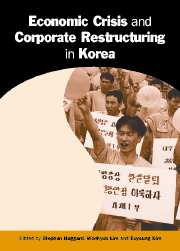Book contents
- Frontmatter
- Contents
- List of Figures
- List of Tables
- Preface and Acknowledgements
- Contributors
- A Note on Usage
- Abbreviations
- 1 Introduction: The Political Economy of Corporate Restructuring
- Part I The Politics and Economics of the Chaebol Problem
- Part II The Political Economy of Crisis Management
- 6 Business–Government Relations under Kim Dae-jung
- 7 The Restructuring of Daewoo
- 8 Bank-led Corporate Restructuring
- Part III Reform and Restructuring
- Index
8 - Bank-led Corporate Restructuring
Published online by Cambridge University Press: 05 July 2014
- Frontmatter
- Contents
- List of Figures
- List of Tables
- Preface and Acknowledgements
- Contributors
- A Note on Usage
- Abbreviations
- 1 Introduction: The Political Economy of Corporate Restructuring
- Part I The Politics and Economics of the Chaebol Problem
- Part II The Political Economy of Crisis Management
- 6 Business–Government Relations under Kim Dae-jung
- 7 The Restructuring of Daewoo
- 8 Bank-led Corporate Restructuring
- Part III Reform and Restructuring
- Index
Summary
As a vicious credit crunch continued into early 1998, the Korean government started to implement an ambitious corporate and financial restructuring program. Understanding that moral hazard and high leveraging played a key role in the crisis, the goal of the restructuring was not only recovery, but also a market system in which shareholders, creditors, management and employees assumed certain responsibilities. Restructuring included efforts to improve the financial soundness of firms through the redeployment of corporate assets and subsidiaries, but also efforts to enhance the managerial transparency of corporations and new corporate governance systems. In contrast to the restructuring of the 1970s and 1980s, the restructuring of the 1990s included not only rehabilitation programs for individual firms and financial institutions but also efforts to change the institutional structure of the economy.
In the corporate sector, the Korean government adopted different approaches to restructuring, depending on firm size (see Chapters 6 and 7). For the largest five chaebol, the so-called Big Deals program called on firms to exchange business lines for the purpose of streamlining their business and focusing limited corporate resources on a few core activities. For the 6th through 64th chaebol and other independent firms, “workout” programs were applied where firms committed to implement a series of restructuring measures in return for debt rescheduling and reduction. In these cases, firms were subject to exit if they failed to successfully implement restructuring measures.
- Type
- Chapter
- Information
- Economic Crisis and Corporate Restructuring in KoreaReforming the Chaebol, pp. 181 - 204Publisher: Cambridge University PressPrint publication year: 2003
- 3
- Cited by

